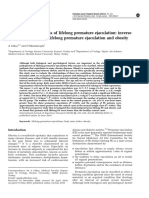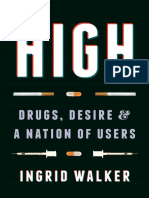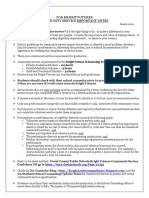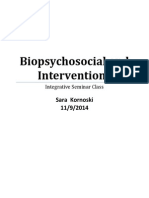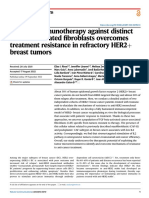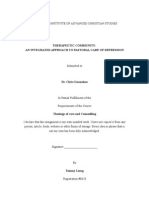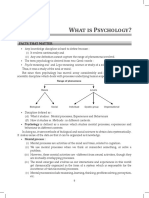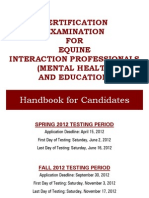Professional Documents
Culture Documents
Content Server
Content Server
Uploaded by
Eduardo Pepe Melgarejo DíazCopyright
Available Formats
Share this document
Did you find this document useful?
Is this content inappropriate?
Report this DocumentCopyright:
Available Formats
Content Server
Content Server
Uploaded by
Eduardo Pepe Melgarejo DíazCopyright:
Available Formats
Volume 44<Number 214ril 2022!Pages 117-132!htlpsi|doi.orgl 10.17744lmehc.44.2.
02
Counseling Clients With Postpartu m
Posttraumatic Stress Disorder: A
Feminist-Trauma Approach
Anna james Krzemieniecki and Elizabeth A. Doughty Horn
Department of Counseling, Idaho State University
Prevalence rates, risk factors, and impact of untreated postpartum posttratimatic
stress disorder (PTSD) are well documented. Despite evidence suggesting that up to
one third of women experience childbirth as traumatic, treatment recommendations'
remain scant. Given the call hor a kntinist appreach to trauma and postpart·um
depression, we highlight a feminist-trauma approach to counseling clients with symp-
turns of postpartum PTSD, based on anN-oppressive feminist-traunia frameworks.
A case study conc·eptualization of a woman experiencing tratimatic stress following
childbirth i, presented to highlight stipportmg research, rationale, and ethical con-
sideratioils.
Approximately one third of women experience childbirth as trittlimitic
(Ayers el al., 2008), and tip to 15% go on to develop postpartum posttraurnatic
stress disorder (]TESD; Grekin & O'1 kira, 2014), a diagnosis that carries an
increased risk of maternal suicide (Harned et al., 2006). Despite evidence to
suggest maternal stlicicle is a leading catise of death diiring pregii.incy and the
postpartum period (Grigoriadis et :11., 2017) and the continued rise in maternal
mortality within the United States, in particular for women of color (Altman
et al., 2020; World Health Organization, 2015), women's inental health
during the postpartuin period often goes unseen and misdiagnosed (Fahey &
Shenassa, 2013; James, 2015: Peeler et al., 2018; Verbiest et al., 2016). Given
the well-documented impact of untreated inatenial niental health symptoms
011 mother, infant, and family (Gartlms-Niegel et al., 2017; Garthus-Niegel,
Horsch, Ayers, et al., 2018; Gartlitis-Niege], 1 lorsch, Ilandlke, et al.. 2018)
and the frequent misdiagnosis and mistreatinent of postpartilin PTSD as post-
partum depression (PPD; Ayers el a]., 2019; White et .11., 2006), the lack of
counseling literature on treatment recominendations for women experiencing
PTS D and traumatic stress following childbirth is .il.imiing (Abdollabpotir et
al., 2016; Ayers et al., 2007,2008)
Anna James Krzemieniecki S https:Norcid.org/0000-0001 -9704-01.53
Correspondence concerning this article should be addressed to Anna james Krzemieniecki, !504
North Main Street, Meridian, ID 83642. Email: [email protected]
0 J ournal of Mental Health Counseling 117
Considering the social and systemic factors associated with childbirth
and mental licalth, counseling w-omen experiencing traumatic stress follow-
ing childbirth requires an approach that recognizes and validates the impact
of systeins of oppression, marginalization, aild discrimination on women'S
mental health (Altmail et :11., 2020). Given the contextual and cillturally sen-
sitive characteristics offeininist counseling, the call for a feminist approach to
trau 1 11 :1 (Tseris, 2013; Wilkin & Hillock. 2014) mid PPD (Davis-Gage et al.,
2010; Mollard, 2015),and the conceptualization of a feminist-traunm frame-
work found in related mental health professions (Wilkin & Hillock, 2014),
the integration of 21 fenlinist-traunia framework iiito counseling with woinen
experiencing FI'SD following child],irth is warranted. In this article, we dis-
ctiss and otilline intervention recommendations utilizing a feminist-traunia
approach for women experiencing distress during the perinatal and postpartum
period. We also present a case study conceptualization to highlight the ilse of
a fei11111ist-trill1111:1 approach.
We note that nian> feminist counselors view· formal diagnostic systems as
01)pressive and discriminatory and recommend iltilizing such systems sparingly
and out of necessity (i.e., when the benefit of using a diagnosis outweighs the
oppressive, stigmatizing nature of diagnosis) and always with the overarching
goal of client empowerment (Evans et al., 2005). The zise of diagnostic codes
and criteria iii this article is in 110 way intended to perpetuate the notion flint
distress equates patliology, neurosis, aitd/or abnorinality.
PERINATAL AND POSTPARTUM MENTAL [1 liALTH
According to Postpartum Support International (2020), women can expe-
rience a liumber of symptoms during the periliatal (i.e., 20 weeks of gestation
until 7 days following childbirth) mid postpartilill pei-iod (i.e., the 12 months
R,Ilowing childbirth; World I lealth Origiziization, 2019). These symptoms
1-ange from mild mood changes, commoillv known as "the baby blties." lo sig-
nific.int symptoms of depression or anxiely, including PTSD and posipartum
psychosis (Postparmin Support Inlernatioual. 2020). However, despite calls
for researchers, practitioners, mid clinicians to conceptiialize matern:11 11,ental
health within a broader- context, PPD remains the primary psychiatric disorder
studied during the postpartum period (White et iii., 2006). Iii conceplii:ilizing
PTSD following childbirth as a co-occurring mid/01- differential diagnosis to
PPD, and becoming familial- With prevalence rates, presenting issues, precipi-
tating factors, and comorbidity, professionals can be better equipped to engage
iii in-depth screening with clients and provide referrals to traumainformed
professionals.
118 0 Journal of Mental Health Counseling
Postpartum PTSD: A Feminist-Trauma Approach
Post-Partum Depression
According to the American Psychiatric Association (APA, 2013), PPD
is ch:iracterized by persistent low mood, anhedonia, and associated somatic
symptoms that Callse significant impairment in social and occupational func-
tioning. Reported prevalence rates for PPD .ire 8%-26%, depending 011 geo-
graphic region (Shorey et al., 2018). According to Shorev et :11. (2018), women
are h#·ice as likely to experience a depressive episode diiring thepa*irtitin
period as compared to any other time in their life. The authors reported typical
onset occtirring within the first 2 weeks :ind 3 11-louths following birth, with
many repoiling symptoms for tip to 1 year (Ugarriza & Schmidt, 2006). Risk
factors for PPD inchicle ulitreated ailtepartum depression. a previous history
of PPD, anxiely during pregnancy, low self-esteem, an unwanted pregizancy,
socioeconoii-lie stress, history of premenstriial d>sphoria, intiltiple births, mari-
tal conflict, sexual abuse iii childhood, negative birth experiences, and young
maternal age (Caple & Wolten, 2018).
Posttratimatic Stress Disorder
PTSD is characterized by rectirrent, involillitary, and distressing memo-
ries or dreams, dissociative reactions. persistent avoidance of associated stimuli,
mid negative alterations in cognitions and moods associated willi a tramnatic
event (APA, 2013; James, 2015). Ctirrently, the APA's (2013) Diagnostic and
Statistical Manital of Mental Disorders ( 501 ed .; DSM-5 ) defines the criteria
for traumatic events as the direct experience of or exposure to actual or tlireat-
ened dealli, serious in jilry, or sexual violence-a definition thal largely ignores
the threats to ps>diological integrity (Briere & Scott, 2015) often reported by
woinen during childbirth. I lowever, as the field of traumatology continties to
grow, researcliers and practitioners are broadening tlie defillition of a traumatic
event for conceptualization and treatment purposes (Briere & Scott, 2015.
AlcKenzie-McH:irg et al., 2015). According to Briere and Scott (2015), "an
event is traumatic if it is extremely upsetting, at least temporarily overwhelins
the individual's internal resources, and produces lasting psychological symp-
toms" (p. 10).
According to James (2015), women who experience a traumatic child-
birth reported symptoins similar to those who experience PTSD brought on by
tratimatic events more commonly associated with the diagnosis. Iii otlier words,
the physical (i.e., risk ofinjury or dealli to herse] for the babv, extreme pain:ind
buidequate pain relief clitrilig labor, higher levels ofobstetric ilitervelition) mid/
or psychological (i.e., perception of a serious threat, feelings of loss of control
and powerlessness) trauma that some women experience during childbirth
can result iii symptoms of PH'SD (Al)dollalipotir et .11., 2016; James, 2015;
7hghizadell et al., 20]4). Currently rese:irchers estiinate Ilia[ approximately
.J ournal of Mental Health Counseling 119
2%-8% of women (tip to 15.7% iii high-risk grolips) nice[ diagnostic criteria
for lil'SD following childbirth (Ayers, 2004; Boon i ian et al.. 2014; Jilines, 2015;
McKerizie-Mci-Iarg et .11., 2015; Schwal, el al., 2012). Additionally, 10.5% of
women report subclinical symptoms of PTS D following eli ildbirth. while 34%
of women report trattinatic experiences during birth (While et al., 2006). Risk
factors for Fl'SD following childbirth include subiective distress iii labor, cur-
rent and previous obstetrical emergencies, infant complications, low support
during labor and delivery, psychological difficulties iii pregnancy, mid previous
trauniatic experiences (Andersen et 21]., 2012; Priddis et al., 2018).
Treatment recommendations for postpartilm 111'SD remain sparse (Cirino
& Knapp, 2019), leaving counselors to rely on generalized approaches to
PTSD that often neglect tlie cultural and ethical considerations relevant to
working with 111is population. It is possible that the lack of literature is influ-
enced by the societal iniplications associated with power disparity ainong geri-
der roles mid by a faillire to acknowledge childbirth as potentially traumatic.
Recommendations specific to FTS[) following childbirth include tratima-
fociised psychotherap> (Cirino & Knapp, 2019), coguitive bellavioral therapy
(CBT; A)-ers et al., 2007), and eye movement desensitization reprocessing
(EMDR: Stramrood et al., 2012), However, these approaches fail to provide
specific recommendations for addressing the experiences commonly reported
br· women, such as destruction of identity, feelings of disempowerment. lack of
trust iii the inedical coinimmity, and social isolation-all commonly reported
by women who experience childbirth as a traumatic event and kev compolients
of a feminist-trailina approicli.
FEMINIST-TRAUMA APPROACH
Feininist counseling theory is a context-based, client-centered approach
that emerged from the feininist movement iii the 1970s iii response to wom-
en's dissatisfaction with mental health services (Davis-Gage d .11., 2010;
Mollard, 2015; Worell, 2001 ). Feminist counselors operate linder the premise
that gender, power, oppression, and culture all contribute to :111 individual's
personal experience. While the ullimate goal of feminist counseling is client
empowerment, feininist coiniselors also pi-ioritize egalitarianism and eng:ige
iii :linilysis of power, gender. and social location (Brown, 2018). hicorporating
tranma-informed care into a feminist theory approach to cozinseling women
experiencing postpa 1-111]n Fl'S D draws 011 [he tenets offeininist counseling Ilie-
on· by focusing on the client as a whole and taking into accolint external causes
of distress (e.g., psychological, biological, :ind cultural) altributed to a client'S
sociocilltur,11 ell\'ironment (Wilkin & Hillock, 2014; Worell, 2001). Iii addi-
tion, these counselors utilize evidence-based, trauma-infornied practices (i.e..
120 .J ournal of Mental Health Counseling
Postportum PTSD: A Feminist-Trauma Approach
fostering provider«lient relationships, minimizing distress :ind maximizing
111101-10]11>, encouraging client disclosure, screening for traimiatic everits, init]-
tidisciplinary collaboration [Reeves, 2015], cliange strategies [Briere & Scott,
2015]). Counselors operating froin a feminist-trauni,1 framework prioritize
the overarching goals of feininist counseling when utilizing traimni-informed
c 1 1.11 i ge strategies (i.e., psychoeducation, distress reduction, affect regulation
tritining, cognitive intenentions, emotiona] processing, mindfulness, and
increasing identity and relational functioning) and avoid defining a client's
beliefs as unrealistic or dysfunctional (Briere & Scott, 2015; Brown, 2018).
Specifically, feminist-trauma counselors work alongside the client lo help them
understand themselves, and their trallimitic experielices, within the larger
context of society (i.e., the personal is political),while striving for equality iii
relationships, balmice in gender roles, self-nurturance, and an acknon ledge-
ment of Cilltillal differences (13:ivis-Gage et al., 2010: Wilidn & Hillock 2014).
To better understand the essence of a feminist-tranina approach to postpartum
PTSD, examples of trallina-iiifornied care are discussed within tile Context
of three overarching goals of feininist theory: empowerment, egalitari:iii rela-
tionships, and gender role anal>sis. Considerations for a feminist approach to
tratima reprocessing are disciissed.
Empowerment
Empowerment, the primary goal of feminist counselors, is defined as
any process by which an individual eillier a) becomes aware of und able to
tise power already available or b) gains access to new ways of being power-
fitl" (Brown. 2018, p. 151). Power is defined as "the capacity to have impact
on self and/or others" (Brown, 2018, p. 152). Feminist counselors engage iii
counseling with the assumption tim[ both counselor :ind client have experi-
enced power und disempowerment :it some point in life, based on individual
experiences and social hierarchies (Brown, 2016). Specific·ally, feminist-trauina
counselors work with clients experiencing PTSD sunploins following child-
birth, litilizing :111 imalysis of power to identify where systemic patriarchies
have influenced bias, stereot)·pe, oppression, diseilipowerment, and emotional
distress throughout pregiancy, birth. und postpartum care.
Additionally, feminist-tranma counselors work to depathologize under-
standable responses to extreme stress, systemic issties, and sociocultural con-
strictions by providing psychoeducation related to the neurobiolog.v of trallina
responses as survival skills and by helping the client conceptualize trauma
as an event tlmt is extreinely upselling, that al least temporarily overwhelms
internal resources, mid timt produces lasting psychological symptoms (Briere
& Scott, 2015; \Vilkin & Hillock, 2014). Wlien counselors validate a Client's
0 Journal of Mental Health Counseling 121
experience as traumatic, clients can feel empowered to regain control over
their experiences (Wilkin & Hillock, 2014). After n sense of balance is restored
and grozinding can be achieved, the client's specific tratima responses can be
exp]ored to depathologize their teelings and behavioral responses to extreme
stress (Wilkin & I lillock, 2014). By becoming empowei-cd willi knowledge,
the client can gain self-awareness, assertiveness, And understanding of realistic
social :md cultural constraints, knowing thai there is nothing inlierently wrong
with them (Brown. 1994. Worell, 2001)
Egalitarian Relationships
Feminist-trauma coilliselors engage in an egalitarilm relationship with
clients to foster an environment where the client is empowered to advocate for
theinselves and heal from traumatic experiences. Egalitarian relationships are
defined as a "model for psychotherapy that simultaneously recognizes inequal-
ities of power inherent in the psychotherapy relationship mid bitilds into t|lat
1„
relationship systemic strategies for making power more equal (Brown. 2018, p.
151). When working to mailitilin an egalitarian relationship with woinen expe-
riencing symptoins of PTSD following childbirth, it is imperative for cotinsel-
ors to reduce tile power differential as nitich as possible. This starts at the very
beginning of the counseling process with infornied consent. Feminist-trauma
counselors discliss client rights, review the counselor's therapeutic approach,
and facilitate space for clients to ask questions. Transparency surromiding lili]-
its to confidentiality is key, Many women have experienced disemponerment
within the medical community as the restilt of having decisions related to
reproduction made for theni. not u il|i theni. By providing a Cle:ir liiiderstand-
ing of limils to confidentiality, including examples of what constitutes stlicidal
ideation, hoinici(lai ideation, child abuse, and Iliandated reporting, clients can
have the personal power to engage in counscling with atitonomy.
Gender Role Analysis
Gender role ankilysis is used 10 11:lve a client identify sex-role messages
they Imve experienced and how those rel:itc to their current life roles through-
out the perinatal und postpartum period. 1 raditional sex-role socialization of
womci] oftei] for])ids women and girls from acting assertively (Smids, ]998),
which c.111 lead to perceived loss of control during pregiiancy, birth, and the
poslpartum period und c.iii contribute to perceiving interactions with niedical
staff as traumatic. For exainple, women who consider their childbirth experi-
ence traitinatic frequently report a dictatorial re],ilionship with medical staff
that includes dismissive staff respouses, conflicting advice, mid/or 110 infornia-
tion on poleliti.11 injuries, which call further exacerbate feelii-igs of helpless-
122 0 Journal of Mental Health Counseling
Postpartum PTSD. A Feminist-Trauma Approach
ness and perceived loss of control (Priddis et al., 2018; Skinner et al., 2018)
Feminist-tramna counselors work with women experiencing lyl'SD following
childbirth to iliiderst:ind those experiences within the political, social, und
cultural coillexts that perpetuale them. When women become empowered
to counteract patterns of helplessness and submissiveness based on sex roles
(Sands, 1998), they can dispute tliose expectations and engage autlientically
during the perinatal period :md throtighout the rest of their lives.
1 rinim.1 Reprocessing
Feininist theory is as inuch ti philosophy and way ofbeing as it is a conn-
seling theory. Within the feminist tradition it is cominonplace to integrate
techniques from other theories and approaches. As previously mentioned,
trauma-focused psychotheripy (Cirino & Knapp, 2019), CBT (Ayers et ill.,
2007), mic] EMDR (Stramrood et al., 2012) are evidence-based practices tliat
have been shown to be beneficial for people with liTSD follouing childbirth.
While counselors who have been trained iii these approaches can incorporate
these into a feil-linist-trailina ;*proach to counseling women experiencing
Pr'SD following childbilth, ethically, they sliotild consider the appropriateness
of sitch intenentions for each client. It is imperative that clinicians are trained
and competent in the trauma-reprocessing interventions they choose to utilize
and/or that they provide proper referrals if necessary.
CASE STUDY
The current case stiidy is focused on a client, referred to as Eleni, based
011 the primary author's personal experiences of providing counseling sen-ices
to women with symptoms of PTSD following childbirth. The purpose of this
case is to demonstrate factors relevant to client conceptualization with this
population (indicated in parentheses) and to demonstrate how providing ther-
apeutic interventions through a femillist-tr.11111121 framework can be utilized
with women experiencing distress consistent with PTSD following traumatic
childbii-iIi experiences.
Backgrotind
Eleni, 8 27-year-old Cauc:IsiaH woman, worked as a teacher prior to deliv-
ering her first child :ipproximately 6 weeks before seeking counseling services.
(Timeline of birth relative to symptoms is iinportant for clinical differentiation
of diagnoses.) She was raised in .1 rtil:11 Southern community and moved to
her current cily to allend college (changes in support). She met her husl);md
Owen, a 30-year-old Small business owner, through 1111111121] friends, sliortly
after beginning her career. They were married for approximately 2 years before
0 Journal of Mental Health Counseling 123
F,leni gave birth. Owen did not have paid paternity leave, so Eleni plalmed
011 returning to work at 6 weeks postpartum (assessing expectations of client
relative to physical mid emotional healing following birth). Eleni's parents
worked full time tind cozild not visit frequently (assessing for supports outside
of the home). Eleiti did not feel accepted by Oweii's parents, 11]ealling Eleni
and Oweil received very little physical and social stipport througholit the post-
partum period.
Presenting Concern
Eleni was refei-red for counseling services by her midwife for PPD :ifter
missing her 4- and 6-week postpartum appoimments. Eleni reported waiiling
to avoid feeling helpless al her follow-up appoilitment with tier midwife.
After engaging in 6 weeks ofservices with a psychiatrist, who diagnosed Eleni
with PPD (assess for misdiagnosish Eleni reported feeling unsupported and
blamed. She then sought out services with a cozinselor she found herself
online (empowernient). Ditring intake, Eleni reported current passive silicidal
ideation, intense feelings of anger when mirsing her baby, shaine for feeling
miattaclied to her child, nightinares of her birth and prior sexual trauma, sleep
disturbances, and forgetfulness (iniportant to assess all symptoms As normalive
or possible tralizim responses)
Collecting Relevant Mental Health I listory
Diiring the intake appointment, Eleni reported aii existing history of
trauma (Cirino & Knapp, 2019), which inchided being raped by a male
acquain[mice al a party iii college wheit she was 18 years old (assess previous
traunia history). She reported seeking comiseling sen-ices following the inci-
deiit for approximately- 2 years through her uiiiversity's health ser\~ices ceiiter.
Eleni reported a history of depression and suicidal ideation following [lie rape:
however, she reported she was asymptoniatic :ind thriving before her preg-
11:111 Cy.
When assessing for external risk factors associated with helplessness mid
loss of control surrounding pregninicy, Eleni reported significant filiancial lind
emotional distress associated with health insurance coverage and with difficulh
finding a provider during her first triniester (disempowerment). 1-lowever, once
slie fotind a provider, Eleni reported feeling stipported after disclosing her
history of:1 sexual trauina ditring an int:ike session with her midwife, stating,
rhey were great about it, They macle sure to limit pelvic exams mid asked
.r
for cons(mi during :iny of my visits" (entpowerment: 11-,11111121-iliformed care).
As Eleni contimied [o discuss her pregiiancy, she reported being hospitalized
during her second Irimesler after reporting significant physical mid emotional
124 0 Journal of Mental Health Counseling
Postportum PTSD: A Feminist-Trauma Approach
hupairnient lasting for 3 weeks, as evidenced by aii jimbility to eat w'ithout
voiniting, stand up for longer than a few minutes, bathe, or drive. She reported
mide]-going invasive medical procedures and was released after two days with
prescribed narcotic paill medication for symptoms. Eleni expressed feelings
of fear, powerlessness, and vulnerability, stating, 'They wotildiA talk to inc or
let me sleep. And after two days iii the hospit.11 and being given medications I
didn'[ want to lake, Iliey released me witli 110 answers." She feared the medica-
tions wolild h.irm her unborn child. She said she felt violated by medical pro-
fessionals and disregarded by her lilidwife, stating, "No one had any answers.
No one would listen. I remember thinking, how was I supposed to trust them
when 1 gave birth?" (diseinpowerment, temponirily overwhelmed interim]
resources, possible tratinia).
Beginning in lier 38th week of pregnancy, Eleni reported an increase iii
symptoms of depression und passive stlicidal ideation, stating, *'I didii't ziant
to kill myself; I iust wanted it .111 to end. My body was in so much pain and 1
coti] d ]1' 1 sleep. [ was niiserable, just waiting to go into labor. I was terrified of
being induced and so angry at my body for failing ine." Eleni also reported a
himily history of tranmatic birth experiences.
When asked to describe her birth experience, Eleni stated, "It was humil-
iating, trciliniatic, 111:id no control. It was like I wasti't allowed lo trlist Iny own
body." She reported she was checked into tile hospital for a medical induction,
where the ntirses insisted on conducting a vaginal exam. After several attempts
to refuse, Eleni said she gave tip and consented to the exam (disempower-
ment). "It took me right back there. 76 that night in college. After thit exam I
don't remember initch. It was a Mur" (possible re-tr,iuinalization). She reported
delivering her daughter vaginally 36 hours later, witli the unplanned lise of
epidural and forceps (discilipowermen[; lack of choice). Eleni reported her
daughter did not start breathing right away, stating, "All of the doctors callie
rushing iii. I didn't get to hold her. I just remember screaining for her. She
wasii't breathing; I thought she w:is dead" (diagnostic qualifier for FISD). She
said she remembered feeling alone, helpless, and uninformed \ihile medical
professionals tended to her datighter (disempowered). Eleni went 011 to sity,
Apparently she just needed some oxygen. They said it was only 2 minutes, but
it felt like an eternity." After knowing that her daughter was okay, Eleni reported
feeling trapped in the hospital as she was tiliable to leave for 48 hours after
dellvering (disempowerment). Ilow-ever, after Eleni returned hoine, approxi-
111.Itely 6 weeks before her intake, she reported strilggling to nurse or care for
her daughter, stating, "My husband is so much better at this. I'm a horrible
mother. She would be better off witholit Ine" (warrants assessment of suicidal
mid homicidal idention)
.J ournal of Mental Health Counseling 125
After obtaining a release of information mid reviewing the risks und ])en-
efits, Eleni's husband Owen was consulted during the last 10 Illintites of the
intake session. Owen reported lie has never seen his wife like this before. He
slated she used to be a "happy-go-]ticky person who cotildn't wait to be a mom."
He reported Eleni had started sleeping in the guest room; was unwelcoining of
visitors, even her best friends (social isolation; avoidance); and exploded with
anger n ben their datighter cried. Owen said he was the primary caregiver for
their daughter but was norried about retuming to work full time iii 2 weeks
(assessinent of support)
Course of Treatment :ind Assessment of Progress
Services with Eleni began by establishing mi egalitarian relationship
through ongoing informed consent, miltual respect, collabonition, and trans-
parency. The counselor discussed her feminist approach and gave Eleni an
informed consent outlining femillist counseling theory to t.ike hoine :ind read.
She was then instructed to reach out with any additional questions before
contililling with services. After Eleni consented to the therapeutic services, the
counselor assessed for safeh and access to basic survival resources (Briere &
Scott, 2015), followed by a biopsychosocial assessinent. where the coilliselor
paid close attention to gender-role expectations, experiences of marginalization
and oppression, und infltlences of societal expectations. Dite to Eleni's history
of sexiial assault, reports of distress associated with PTSD, and stlicidal ideation,
which she disclosed early iii the session, the counselor engaged Eleni iii safety
planning. After a safety plan was established, the coiii iselor discussed the fre-
quent misdiagnosis of PTS D following childbirth as P PD. Collaborativel>, the
two talked aboii[ the purpose of diagnostic criteria as a way to narrow dowii
more effective intel-~-entions and the systeinic contribritions to niisdiagnosis in
the perinatal period.
Initially, tile decision w:is made to tempor:irily suspend significant discus-
sion of tralima mid assess psychological stability and stress tolerance (Briere
& Scoll. 2015). Operating from :1 feminist framework. this decision w·:is macie
iii collaboration witli Eleni after discussing the importance of 111:lilitailling
stability and the possibility of an activation response occurring (Briere & Scott,
2015; Wilkin & Ilillock, 2014). The intake assessinent conchided with brief
psychoediication of trimina respouses arid 11011101)iology to lioritialize, rather
thaii palliologize, Eleni's reaction to trall]11.1 (Wilkin & Hillock. 2014).
Treatment Goals
1 liree gotils .ind cori-espondiug objectives were collaboratively identified
mid focused 011 personal empowerment (Worel], 2001 )
126 0 Journal of Mental Health Counseling
Postpartum PTSD: A Feminist-Trauma Approach
Co:111. The first goal was to increase a seiise of personal control. The cor-
responding objective was to focus on "perceived internal control/self-efficacy
(\Vorell, 2001, p. 340). Due to the pressing concern related lo Eleni's avoid-
ance of medical professionals. il was concluded thal her tratinia was ongoing
(Briere & Scott, 2015). She reported needing to seek medical treatment and a
physical postpartillil exalilination, which she felt she had no control over. She
said she viewed her niidwives as perpetrators mid did not waill to see them for
a follow-up exam. In session, Eleni explored what cont·rol she had over the
situation and engaged in assertiveness training to increase lier sense of control.
After feelillg empowered and informed of her options related to health care
providers, she chose a new health care provider who underslood and accom-
modated her needs. Ultimately, Eleni reported she was able to assert her power
and felt in control of seeking flirther healthcare treatment.
Coal 2. The second goal was to increase positive self-evaluation. Eleni
reported experiencing feelings of worthlessness and guilt 1-elated to the lack
of attachment she felt towards her datighter. The objective was to focus on
"positive self-esteem and self-valiting" (Worell, 2001, p. 340), utilizing psyclio-
edilcation und gender role alialysis. Eleni :ind tile counselor discussed psycho-
education regarding Ille lieurobiology of |raulli.1 theory, inchiding flight/fight/
freeze, optinial bal.ince (nontrcizimatic response) versus collapse/numbing
dissociation (traumatic response), and Ihe "tend and befriend" theory, along
with power :111:ilysis :ind evalization of geiider roles (Wilkin & Hillock, 2014).
By understanding that her response was a normal reaction to .1 [-ratiinatic event,
and redefining her life roles in an authentic way, Eleni was able to shift into a
more positive self-evaltiation.
Goal 3. The third goal w:is to reduce distress iii daily life associated
with sex-role expeclations. The access to resolirces (i.e., physical und social
stipport) Eleni had with her husband at home were quickli- coming to ali end.
The objective was to tocils 011 exploring "access/use of rein-ant personal :md
community resources" (Worell, 2001, p. 340), while exploring political, social,
:ind cultural influences on sex-role expectations. B>· identifying new und exist-
ing physical mid emotional supports available to her, mid by disptiting beliefs
associated with sex-role expectations that acted as barriers to accessing supports,
Eleni gained nceded physical and emotional support while understanding that
she was not aloile ill her feelings or experiencing of a traumatic event, power-
lessness, and loss of control during birth.
trauma Rel)rocessing
Dite to lize ethical consider.itions and training recltiirements indicative of
trauma-reprocessing techniques and interventions, Elem's trauma reprocessing
01 ournal of Mental Health Counseling 127
will be discussed generally, identifring themes tlial could emerge w·ililin :my
Level 2 tratiina approach. Once Eleni's distress was reduced, and she was
able to intentionally regulate her arousal to trattimi 1-riggers (e.g., the result
of trauma-informed practices lo regillate the atitonomic nervolis system),
the counselor discussed the elhical implications and treahnent oplions for
Level 2 tr,mina work. hi an effort to empow·el- Eleni, the counselor celticated
her on current [realmen[ recommendations for reprocessing vivicl images,
feelings of helplessness, and triggering stimuli associated with PTSD following
childbirth, which include trauma-foctised psycholherapy (Cirino & Knapp.
2019), trauma-focused CBT (Ayers et al., 2007), and EMDR (Stramrood et al.,
2012). Elen i was infornied of literature to consider related to currcut trealment
recominendations s])ecific to postpartuin PTSD and the general population
(empowerment). Given Eleni's counseling history· litilizing a feminist-trauma
frmnework, traima reprocessing focused on theines of power, gender role
expectations, and self-empowerment. Specifically. the counselor worked
alongside Eleni (egalitariaii relationship) to reduce distress associated with the
birth oflier daughter and to achieve the zillimate goal, empowerment, by repro-
cessing triggering events associated with accessing care, in an effort to reduce
reactivity when intenicling with medical staff iii the future.
Other Considerations
Considering the tremendous effects ti illother's s)-11-lptoms of postpartum
1 1 317 11.ive on the infant. partiler, and family (Garthus-Niegel et aL 2017;
Garthus-Niege], Horsch, Ayers et al., 2018. C:artlitis-Niegel. Horsch, Haildtke
et cil,, 2018), it is imperative to 111:linlain informed consent and a working
relationship with Eleni's other healthcare providers mid her daughter's pediatri-
cian. It is also important to inchide Eleni's husband :ind daughter throughout
the course of counseling, It is recominended that Eleni brings her daughter
to sessions with her so the comiselor call assess parental-infant :ittachinent
and engagement iii session as a way to mensure improvement throughorit the
course of counseling (Jung et al., 2007). Additionally. with client consent, il
is important to engage iii occasiona] constiltations with her litisband and/or
refer [lient both out for additional fainily counseling with another counselor to
increase physical and emotional support needed during the post]):irtiii ]1 period.
DISCUSS[ON AND [.IMITATIONS
Historically, the ineutal |]Calth colmnunity has dis111issed [raimia experi-
enced during child],irth as a precipitating event to PTSD. Civen that approx-
imately half of the world's poptilation are women, and knowing thal Hoilien
:irc more l i kely t] 1.111 men to 11 l i l i ze mel i tal h ealt h services ( S i n i th et al ., 2013),
128 01 ournal of Mental Health Counseling
Postportum PTSD.- A Feminist-Trauma Approach
clinicians shotild conceptualize a Homan's experience of infertility struggles,
pregnancy loss, pregiumcy, childbirth, and the post])211-tum period through a
tr:mma-informed lens. However, given Ilie vulnerability of this poptilation,
counselors looking to integrate a feminist-trauma framework into their work
with clients shotild be mindful of the limitations of the framework and the
additional ethical considerations within the context of the unique needs of their
clients. When conceplitalizing the limitations, it is important to acl<iiowledge
the conceptual nature of a feminist-traumil framework. More otitcome research
is needed on effective counseling approaches, including different theoretical
approaches, individual versus grotip comiseling outcoines, support grozips,
effectiveness of provider constiltation during the perinala] period, and coun-
seling interventions and outcomes with diverse populations.
Another limitation includes the at times contradictory nature of feininist
and h-auin:i theories individually (Wilkin & Hillock, 2014). P'or example, con-
sidering that iii:iternal suicide is a leading cause of death diiring pregilancy
and tlie postpartum period (Grigorindis et al., 2017) and that there is a doc-
umented increased risk of siiicide associated with 21 history of PTSD (Harned
et al., 2006), it is imperative for clinicians working with women experiencing
postpartum PTS D to engage iii ongoing safety assessment both for non-suicidal
self-injurv and for suicidal ideation, plan. and intent. While [his constihites
ethical practice. one could perceive this to contr:idiot the tenets offeininist the-
ory. Additionally, for counselors working with this popillation, it is important
to differentiate negative self-talk and obsessive thoughts from Ille vistial and/or-
auditory hallucinations and dellisions thal accompany postpartuni ps>chosis.
Postpartum psychosis tends to present as bipolar depression shortly after birth,
frequently with women who do not have a history of hallticinations and/or
delusions. \Vhile the feillillist-trauma framework presented may be appropriate
for PPD mid aiixiety disorders, whicli favor outpatient mental health services,
the heightened risk for suicide and/or infanticide that accompanies postpar-
tum psychosis may warrant hospitalization (O'H:Ira & Wisner, 2014), Further
exploration is needed to miderstand the applicability of this franiework with
clients experiencing postpartuin psychosis and in inpatient settings.
0 Journal of Mental Health Counseling 129
REFERENCES
Abdollalipour, S., Khosravi, A.. & Boil,ollinghighi. N. (2016). 1 he effects of the magic hour
on post-traumatic stress disorder ( PTSD ) in traumatic childbirth : A clinical trial . lournal 01
Reproductive and ln/ant /4·yi·hology, 34(4), 403-412.
Altnian, M. R., MoLentore, M. R.,Oseguera, T., 1 midon, A.. & Franck, L. S. (2020).Listening
to women: Recommendations from women of color to improve experiences iii pregnancy atid
Ibirth care . Journal of .Alic/wi/kn· and Womenk· 1 lecilth , 65 (4 ), 466-473 .
1-ittps://doi.org/10.1111/fiii#·Ii. 13102
American Ps,·chiatric Association . ( 2013 ). Diagnostic and Rtalistical manual of mental disorders
(5til ed. 1. https:#doi.org/10.1176/appi.books.9780890425596
Andersen, L, B,, Melvaer, L. B.. Videbecli, P., Lamont, R. F., & joergensen, J. S. (2012). Risk
fae tors for developing post-truumatic stress disorder following childbirth: A s,stematic review.
Acm Obxletricia et ('rnecologica Scandinarica, 9 L ] 261-1272.
littps:#doi.org/10.11114.1600-0412.2012.0]476.x
A>·ers, S. (2004). Deliven· as a traumatic event: Prevalence. risk factors and treatment for postliat.11
post-traumatic stress disorder. Clinical ( )bstetrics ( h,nec·ology, 47( 3 ), 552-567 .
https://doi.org/10.1097/01.grf.0000129919.00756.90
Avers. S.. Joseph. S.. McKenzie-Alcilarg. K.. Slide. R.& Wilma. K. (2008). Post-traumatic 3tress
disorder following childbirth : Current issues und recommendations for future research . Aimal
0/-14¥chosomalic· Obstetrics and (;inecology, 29(4), 240-250.
https://doi.org/10.1080/01674820802034631
.Avers. S., NicKenzie-McHarg, K., & Eagle. A. (2007). Cognitive behaviour therap,· for postiiatal
post-traumatic stress disorder: Case studies . }ournal of PArhrmoniatic Obstetrics ,md Gy,iecoh,gy,
28(3), 177-184. https://doi.org/10.1080/0167482060] 142957
Avers, S.. & Sawyer. A. (2019). The impact of birth on women's health and wellbeing. In
O. 1-litibman-Ben-Ari (Ed.), Pathways and barriers to parenthood ( pp . 199-218). Springer.
https://doi.org/10.1007/978-3-030-24864.2_12
Boorman, R. J., Devillv, C. J., C,amble, J., Creed,·. D. K.. & Fenwick, L (2014). Childbirth and
criteria for traumatic evenb. \ jiditi/erv. 30.255-261.
https://doi.org/10.1016/1.midw.2013.03.001
Briere , J . N ., & Scott, C . ( 2015 ). PrincipleN of trauma therapy: A guide to xymptonix, evalucition
and treatment. Sage.
Brown , I .. S. ( 1994). Subven·ire dialoguex. Theory iii feminist therapy. Basic Books .
Brown, L. S. (20161. Supervision essentials for the feminist Mchotherapi' model ofsupen'ision.
American Psychological Association.
Bronii , L. S . ( 2018). 1 ''eminix·1 therapy ( 2"'1 ed.). American Psveliological Association .
Caple. C.. & Woten, M. (2018). Postpartum depression: Psychosocia] support. Nursing Re/erence
Ceiiter.
Cirino, N. H., & Kinipp, J, M. (2019). Perinatal posth-auinatic stress disorder: A re\·iew of risk
factors. diagnosis. and treatment. Obstelrical uncl ( ;ynecological Sun·ev, 74(6). 369-376.
littps://doi.org/1 0.1097/00:1.0000000000000680
Dmis-Gage, D., Kettman. J J, & Moel, J. (2010). Developinental transition of motherhood:
Treating postpartum depression using a feminist approach . Adullspan 1{jurnal, 9( 2 ), 117- 126.
https://doi.org/10.1002/j.2161-0029.2010.tb00076.x
Evans, K. M., Kinc:ide, E. A., Marbles, A. F.. & Seem. S. R. (2005). Feminism and feminist
therap\·: Lessons from the past and hopes for the future. Murnal of (:ounse/ing ancl
Deve/opment. 83(3), 269-277. https://doi.org/10. ]002/j. 1556-6678.2005.tl)00342.x
Fahey, J. 0.. & Shemiss:i, E. (2013). liziderst.nidingand meeting the needs of women in the
postpartu m pe riod: The perinatal mal·ernal ] iealth pro motion 11 7 odel . Journal Of A lidiviferv and
Women'A· Health, 58(6),613-621. I ittps://doi.org/1 ().Illl/imwil. 12139
Garthu,-Niegel, S,,Ayers, S., Martini. L von Soest. T., & Eberhard-Gran, M. (2017). The impact
of postpartum post-traumatic stress disorder simptoms on i·Mid development: A population-
based, 2-vear follon -up stitch·. Psychnlogical .1ledic·ine, 47( 1). 161-170.
h tips:#doi.org/1 0.101 7/S{)()3329171600235X
Carthus-Niegel, S., Horseli, A,, Avers, S., Junge-I loffmeister. J.. Weidner, K., & Eberhard-Gran.
Al, (20 18). The influence of postpartilill PTSD on breastfeeding: A longitudin.il population-
based $tildv. Birth. 45( 2 ), 193-201 . littps:#doi . org/ 10. 1111 /birt. 12328
130 0 Journal of Mental Health Counseling
Postportum PTSD: A Feminist-Trauma Approach
Garthus-Niegel. S., Horsch, A., Handthe. E., voii Soest, 7..Ayers, S., Heidner, K., & Eberliard-
Gran. M. (2018). The impact of postpartum posttratimatic stress and depression symptoms on
couples' relationship satisfaction: A population-based prospective shidv. Frontiers in Pnychology,
9, Article 1728.littps://doi.org/10.3389/fpsyg.2018.01728
Grekin, R.. & 07 lara, M. W (2014). Prevalence and risk factors of postpartum posttrallinatic
stress disorder: A meta-analvsis . Clinical Psychology Review, 34( 5 ), 389-40 ].
littps://(loi.org/10.10164.cpr. 2014.05.003
Grigoriadis, S., Wilton, AS.,Kurd>ak, P. A.. Rhodes, A.E., VonderPorten, E. i L Levitt,
A., Clieting. A., & Vigod, S. N. (2017). Perinatal suicide in Ontario, (imad:i: A 15-vear
population-based stildv. CMA j.· (Janadiati A.ledical .1.q.Nocialion /Ounm/, 1%9(34), El 085-
1€1092. littps:#doi.org/10.1503/emai.170088
11:inied, Al. S., Nalavits, L. M., & Weiss, R. D. (2006). Self-harm and suicidal liehavior iii
women with comorbid FI 'SD and substance dependence . American journal on Addictions.
15(5), 392-395. littps://doi.org/10.1080/10550490600860387
James, S. (2015). \\'omen's experiences ofsvmptoins of posttrauinatic stress disorder (PTSD) after
traun mtic childbi rth : A review and critical .ippraisal. Archives of Women's Mental / lealth. 18.
761-771. littps://doi.org/10.1007/s00737-015-0560-x
Jung. V., Short, R.. Letourneau, N., & Andrews, D. (2007). Interventions with depressed molliers
and their infants: Modift·ing interactive behaviours. journal of.\#ective Dimirders, 98,199-205.
I ittps:#doi.org/10.1016/i·ind.2006.07.014
Mi Kenzie-AlcH.irg, K., Ayers, S., Ford, E.. Horsch, A., Joineen, J.. Sawyer, A., Stramrood, C..
Thombon. G.. & Slade. P. (2015).Post-traumatic stress disorder following childbirth: An update
of current issues and recommendations for fumre research . lournal of Reproductive and Infant
Prrchology, 33(3),219-237. littps:#doi.org/10.1080/02646838.2015.1031646
Mollard. E. (2015). Exploring paradigms iii postpartum depression research: The need for
feminist pragmatism. //ealth Care }or Womeit Interticitional. 36. 378-391 .
https://doi.org/10.1080/07399332.2014.90395 1
01-1.ira, M. W., & Wisner. K. L. (2014). Perinatal mental illness: Definition, description and
ctiology. Best Practice and Research (:/inical ()/mletrics and Gynecology, 28(1), 3-12.
littps:Udoi.org/10.1016/1.bpol,grn.2013.09.002
Peeler. S., Stedmon, J., Cliumg. M. C.. & Skirton, H. (2018). Women's experiences of living with
postnatal FTSD. Alidwi/bly, 56,70-78. littps://doi.org/10.1016/i.midw.2017.09.019
Postpartuni Supportlnternational. (2020). Frequently ah·ked questions·. litlps:/Avww.postpartum.
net/learn-more/frequently-asked-questions/
Priddis, H. S., Keedle, Ii.. & Dahlen, H. (2018).The perfect storm oftrauma: The experiences
of women who have experienced birth truuma and subsequently accessed residential parenting
services in Australia. \Vomen and Birth, 3 1 (1), 17-24.
h Bps://doi.org/10.10164.wombi.201 7.()6.007
Reeves, E. ( 2015 ). A syntliesis of the literature on trauma-informed care . Issues in \/ental Health
Numing, 36(9), 698-709. https://doi.org/10.3109/01612840.2015.1025319
Sands. T. ( 1998). Feininist counseling and feniale adolescents: Treatment strategies for
depression. Munial Of \lental / lealth Counseling, 20(1),42-65.
Schwab. W., Marth. C., & Bergant, A. (2012). Post-traumatic stress disorder postpartum.
Geburtshil/e und Frauenheilkunde, 72(1), 56-63. httl,s://doi.org/10.1055/5-0031-1280408
Shorev, S., Chee, C. Y. 1., Ng, E. D., Ch:iii, Y. H.,Tam, W. W. S.. & Chong, Y. S. (2018).
Prevalence and incidence of postpartilin depression imong healthy mothers: A systeniatic
Imiew und Inet,1-an.ik·his. jounial of/inrhiatric· Re.search, 104,235-248.
littps://doi.org/10. 1 016/hipsyclii res.2018.08.001
Skinner, E. M.. Barnett. B., & Dietz, H. R (2018). Psychological consequences of pelvic floor
traunia following vaginal birth: A qualitative stude from hvo .Atistraliaii tertion· 1]iaternitv units.
Archiws ofWomen's Mental 1 lealth, 21. 341-351. littps://doi.org/10.1007/sOC)737-017-0802-1
Smith, K. 1.. W., Matheson. F. 1., Moineddin, R., Dunn. J. R., Lu, H.. Cairnev, J., & Glazier,
R. H. (2013). Cender differences iii n iental health senice utilization among respondents
reporting depression in a natioital health survey·. 1 led/th, 5(10), 1561-1571.
littps://doi.org/10.4236/health.2013.510212
Stramrood, C.A.I., \ an der Vel(le, 1.. Doornbos, 13., Paarlberg, M., Schultz, W., & van Pampus. M.
(2012). The patient obsen-er: Eye-movement desensitization .11 i d reprocessing for the treatment
.J ournal of Mental Health Counseling 131
of posttrailinatic stress following childbit||1. Birth INSues in Perinatal Care, 39( 1), 70-76.
I ittps:#doi.org/10.1111/1.1523-5 36X.20 1 1.00517.x
Thihizadell, S.. in®our, A., Nediat. S., Arl)01)i. Al. & I.opez, V. (2014). iranian mothers'
perception of the psrchological birth trauma: A qualitative stud,·. trimian lounicil of- Pxrchicitry,
9(1), 31-36
f ~eris. E. J. (2013). Traum:i theon- without feminism? Evaluating contempor.iry understandings
of traum.itized women . lournal of WO' lle'/1 and Social \Vork, 28(2 ), 152- 164.
littps://doi.org/10.1177/0886] 09913485707
ligarriza , D . N . & Schmidt, L. (2006). Telecare for women with postpartum depression . lounial
of liychosocial Nun·ing, 44( 1), 37-45. littps:#doi.org/10.3928/02793695-20060101-08
Verbiest, S., Bonzon, E., & 1-[andler. A. (2016). Postparhim health and wellness: A call for qualih·
wonian-centered care . Maternal and CIiild Heailli journal, 200\), \-7 .
littps://doi.org/] 0.1007/s [0995-016-2188-5
White, T. Mattliev, S. Bovd, K. & Barnett. B. (2006). Postliatal depression and post-traumatic
stress after childbirtli: Prevalence, couise and co-occurrence. ic,tinial of Reproductive aiid
infant P.~ydmlogy, 24(2), 107-120. https://doi.org/10.1 080/02646830600643874
Wilkin. L., & Hillock, S. (2014). Enhancing MSW students'efficacy in working witli traunia,
violence, mid oppression: An integrated feminist-trat1111:1 framework for social work education.
Feminist 'lbc,cher, 24(3), 184-206. littps://doi.org/]0.5406/femteacher.24.3.0184
Worell J. (2001). Feministinterventions: Accountabilih· bevond symptom reduction. Psychology
of\¥omen Quarterly, 25, 335-343. littps://doi.org/10.1111/14,1-6402.00033
Woild Health Organization. (2015). Trends inmatental mortality: 199() lo 2015. littps://apps.who.
inUiris/bitstream/liandl e/ 10665 /193994/W l 10_RH 11_ 1 5.23_eng.pdf?sequence= 1
World Health Organization . (2019). Maternal and perimital health. littps://www.1, 110. ii] U
maternal_cliild_adolescetit/topics/niaternal/maternal_perinatal/en/
132 0 journal of Mental Health Counseling
Copyright of Journal of Mental Health Counseling is the property of American Mental Health
Counselors Association and its content may not be copied or emailed to multiple sites or
posted to a listserv without the copyright holder's express written permission. However, users
may print, download, or email articles for individual use.
You might also like
- Ebook PDF Theories of Counseling and Psychotherapy An Integrative Approach 2nd Edition PDFDocument42 pagesEbook PDF Theories of Counseling and Psychotherapy An Integrative Approach 2nd Edition PDFflossie.thompson264100% (43)
- ABC7Document6 pagesABC7Melissa R.100% (3)
- Unit 16 - Inequalities in Health and IllnessDocument8 pagesUnit 16 - Inequalities in Health and IllnessOlatokunbo SinaayomiNo ratings yet
- Stanislav Grof - Beyond The BrainDocument526 pagesStanislav Grof - Beyond The BrainMarruh96% (23)
- Personal Journey of Cultural Exploration Paper (Yeo)Document16 pagesPersonal Journey of Cultural Exploration Paper (Yeo)Cash RobinsonNo ratings yet
- Mynhier - LuskinSchoolofPublicAffairs.PA40 (Summer 2021) (Last Modified 2021-08-3 - 07-00)Document9 pagesMynhier - LuskinSchoolofPublicAffairs.PA40 (Summer 2021) (Last Modified 2021-08-3 - 07-00)Wang YichenNo ratings yet
- Tiera Couch Evaluation of Client SituationDocument11 pagesTiera Couch Evaluation of Client Situationapi-249417164No ratings yet
- Rochat & Armengol (2018)Document13 pagesRochat & Armengol (2018)Alejandro AlmarazNo ratings yet
- Highlights From DAWN: Baltimore, 2002: DAWN: The Warning NetworkDocument4 pagesHighlights From DAWN: Baltimore, 2002: DAWN: The Warning NetworklosangelesNo ratings yet
- Group Work ProcessDocument10 pagesGroup Work ProcessBimal Antony100% (1)
- Counseling Treatment PlanDocument2 pagesCounseling Treatment PlanArhann Anthony Almachar Adriatico100% (1)
- Workbook UNIV 100Document59 pagesWorkbook UNIV 100Quratulain MustafaNo ratings yet
- Chif KUDocument7 pagesChif KUJoseph AbugaNo ratings yet
- Social SciencesDocument23 pagesSocial SciencesRhea LanuzaNo ratings yet
- Terminations and ReferralsDocument3 pagesTerminations and ReferralsabcdNo ratings yet
- Sederer Expert Report Publicly FiledDocument157 pagesSederer Expert Report Publicly FiledBrit StackNo ratings yet
- 01.behavioral Helath 3 BlocksDocument403 pages01.behavioral Helath 3 BlocksNicolás LaverdeNo ratings yet
- Handbook SEC 0910Document67 pagesHandbook SEC 0910NIST Ele ICT DepartmentNo ratings yet
- Re-Entry Guide 2017 - Web PDFDocument242 pagesRe-Entry Guide 2017 - Web PDFJohn TuringNo ratings yet
- FMRHS Student HandbookDocument36 pagesFMRHS Student HandbookFall Mountain Regional School DistrictNo ratings yet
- Suffolk County Substance Abuse ProgramsDocument44 pagesSuffolk County Substance Abuse ProgramsGrant ParpanNo ratings yet
- PHR DrugCourts ReportDocument26 pagesPHR DrugCourts ReportCris Reyes OrtizNo ratings yet
- Understanding Mental Health First Aid 2020Document68 pagesUnderstanding Mental Health First Aid 2020Viridiana Acuña Díaz100% (1)
- Capella Admisions RequirementsDocument6 pagesCapella Admisions RequirementsDamian CrequeNo ratings yet
- Insight On Pathogenesis of Lifelong Premature Ejaculation: Inverse Relationship Between Lifelong Premature Ejaculation and ObesityDocument4 pagesInsight On Pathogenesis of Lifelong Premature Ejaculation: Inverse Relationship Between Lifelong Premature Ejaculation and ObesitymaithamNo ratings yet
- The Stoning of Soraya M. EditedDocument8 pagesThe Stoning of Soraya M. EditedNisa BhuttaNo ratings yet
- Rawson Expert Report Publicly FiledDocument83 pagesRawson Expert Report Publicly FiledBrit StackNo ratings yet
- Child Adol Traditional Biopsychosocial TemplateDocument11 pagesChild Adol Traditional Biopsychosocial Templateyeney armenteros100% (1)
- Mephentermine Abuse For Stamina, Resulting in Mania - A Case ReportDocument4 pagesMephentermine Abuse For Stamina, Resulting in Mania - A Case Reportgaurav sharmaNo ratings yet
- Lotufoneto 2004Document3 pagesLotufoneto 2004Nera MayaditaNo ratings yet
- Advocacy Services For Adults With Health and Social Care Needs PDF 66143840705989Document82 pagesAdvocacy Services For Adults With Health and Social Care Needs PDF 66143840705989Yilianeth Mena DazaNo ratings yet
- Sociology Readings and Case StudiesDocument75 pagesSociology Readings and Case StudiesJuliaNo ratings yet
- November 2008Document8 pagesNovember 2008novvotikNo ratings yet
- Black Womens Careers Within USA - ReportDocument38 pagesBlack Womens Careers Within USA - ReportRayNo ratings yet
- Democracy Vs DesireDocument10 pagesDemocracy Vs DesiresergiolefNo ratings yet
- EnglishDocument31 pagesEnglishAdwaith ShineNo ratings yet
- Abpsych LectureDocument6 pagesAbpsych LectureMG SarabosingNo ratings yet
- High: Drugs, Desire, and A Nation of UsersDocument37 pagesHigh: Drugs, Desire, and A Nation of UsersUniversity of Washington PressNo ratings yet
- Brian Loma v. City and County of Denver, Et Al.Document34 pagesBrian Loma v. City and County of Denver, Et Al.Michael_Roberts2019No ratings yet
- 3 Accreditation Licensure 9.12.08Document14 pages3 Accreditation Licensure 9.12.08Lauren Russell StephensonNo ratings yet
- Notes For AA BookDocument15 pagesNotes For AA BookBrittany Nicole GrateNo ratings yet
- When Domestic Violence and Sex-Based Discrimination Collide - CiviDocument49 pagesWhen Domestic Violence and Sex-Based Discrimination Collide - CiviHNo ratings yet
- DisordersDocument10 pagesDisordersAra MiaNo ratings yet
- Community Service Important Points Updated 20-21Document1 pageCommunity Service Important Points Updated 20-21mortensenkNo ratings yet
- Substance Use Disorders NotesDocument5 pagesSubstance Use Disorders NotesJuanchovieldiazNo ratings yet
- Counselor Retention-TransferDocument3 pagesCounselor Retention-TransferSheila BanuelosNo ratings yet
- Drug Addiction As A Pathology of Staged NeuroplasticityDocument15 pagesDrug Addiction As A Pathology of Staged NeuroplasticityPamGarcíaNo ratings yet
- DhatDocument11 pagesDhatLetterio NaccariNo ratings yet
- Nurses Experiences of GriefDocument14 pagesNurses Experiences of GriefRonay GokilNo ratings yet
- 10A28641 2 2011-09-28 DepositionOfDrGeraldTGowittMD OcrDocument34 pages10A28641 2 2011-09-28 DepositionOfDrGeraldTGowittMD OcrsnippyxNo ratings yet
- What Are Your Legal RightsDocument11 pagesWhat Are Your Legal RightsEmran ZeinNo ratings yet
- MalariaDocument12 pagesMalariaManish DasNo ratings yet
- Psychology Eric BeckDocument5 pagesPsychology Eric BeckAnnaNo ratings yet
- Biopsychosocial and Interventions PaperDocument13 pagesBiopsychosocial and Interventions Paperapi-272668024No ratings yet
- Guidance and Counseling - Reported by Abdulazis C. AbdulnasserDocument8 pagesGuidance and Counseling - Reported by Abdulazis C. AbdulnasserAbdulazis C. AbdulnasserNo ratings yet
- Narcissistic Personality DisorderDocument12 pagesNarcissistic Personality DisorderYashika Jain -63No ratings yet
- Delantar Matrix of Pychological DisordersDocument123 pagesDelantar Matrix of Pychological DisordersYvette Claire DelantarNo ratings yet
- Drug AddictionDocument12 pagesDrug AddictionZohrahLiaqatNo ratings yet
- Drug Benefit ListDocument221 pagesDrug Benefit ListPharmaruthiNo ratings yet
- Digital Scheme Chart Jan'22Document192 pagesDigital Scheme Chart Jan'22Abhishek SoodNo ratings yet
- Depression PDFDocument9 pagesDepression PDFfastchennaiNo ratings yet
- GES Exams RulesDocument5 pagesGES Exams RulesKwabena AgyepongNo ratings yet
- Greenwalt - CVDocument11 pagesGreenwalt - CVapi-328608667No ratings yet
- Birth Trauma and Post Traumatic Stress Disorder The Importance of Risk and ResilienceDocument5 pagesBirth Trauma and Post Traumatic Stress Disorder The Importance of Risk and ResilienceMsRockPhantomNo ratings yet
- Running Head: Depression Screening 1Document26 pagesRunning Head: Depression Screening 1api-456313554No ratings yet
- Pòlitica AmbientalDocument1 pagePòlitica AmbientalEduardo Pepe Melgarejo DíazNo ratings yet
- Pi Is 0002937822002277Document16 pagesPi Is 0002937822002277Eduardo Pepe Melgarejo DíazNo ratings yet
- Evolution of Immune Genes Is Associated With The Black DeathDocument22 pagesEvolution of Immune Genes Is Associated With The Black DeathEduardo Pepe Melgarejo DíazNo ratings yet
- Targeted Immunotherapy Against Distinct Cancer-Associated Fibroblasts Overcomes Treatment Resistance in Refractory HER2 + Breast TumorsDocument16 pagesTargeted Immunotherapy Against Distinct Cancer-Associated Fibroblasts Overcomes Treatment Resistance in Refractory HER2 + Breast TumorsEduardo Pepe Melgarejo DíazNo ratings yet
- Pastoral Care of DepressionDocument12 pagesPastoral Care of DepressionTommy Liang100% (1)
- Self-Administered EFT (Emotional Freedom Techniques) in Individuals With Fibromyalgia: A Randomized TrialDocument6 pagesSelf-Administered EFT (Emotional Freedom Techniques) in Individuals With Fibromyalgia: A Randomized TrialInnoVision Health Media100% (1)
- DSM PresentationDocument16 pagesDSM Presentationapi-548853432No ratings yet
- Mental Health Nursing RequirementsDocument5 pagesMental Health Nursing RequirementsNuay LaoNo ratings yet
- Transcript of Applied Social SciencesDocument14 pagesTranscript of Applied Social SciencesIssaVillanuevaNo ratings yet
- 1455778993psychology 11 - (CH 1)Document21 pages1455778993psychology 11 - (CH 1)Tiki Sharma50% (2)
- Michigan Legislative Analysis - SCOPE OF PRACTICE FOR COUNSELORS 2019-HLA-4325-7B3BE14ADocument5 pagesMichigan Legislative Analysis - SCOPE OF PRACTICE FOR COUNSELORS 2019-HLA-4325-7B3BE14ABeverly TranNo ratings yet
- Career Research Assignment - Clinical PsychologistDocument2 pagesCareer Research Assignment - Clinical Psychologistapi-527916921No ratings yet
- CBEIP Certification HandbookDocument21 pagesCBEIP Certification HandbookKay Sudekum Trotter, PhDNo ratings yet
- Student Treatment Session Soap 8Document9 pagesStudent Treatment Session Soap 8api-340625860100% (1)
- ACTforPsychosisRecovery Chapter 1Document25 pagesACTforPsychosisRecovery Chapter 1quentelllNo ratings yet
- Martha Rice: ObjectiveDocument1 pageMartha Rice: ObjectivePewitt Junior HighNo ratings yet
- Open Studio ConceptDocument7 pagesOpen Studio ConceptSantiago González HernándezNo ratings yet
- FDP 301x - Course Journal - Mithesh KumarDocument5 pagesFDP 301x - Course Journal - Mithesh KumarMithesh KumarNo ratings yet
- Behaviorism, Cognitivism, and Constructivism:: Reflections On Persons and Patterns in My Intellectual DevelopmentDocument14 pagesBehaviorism, Cognitivism, and Constructivism:: Reflections On Persons and Patterns in My Intellectual DevelopmentNiniNo ratings yet
- Constructive Social Work: Unit 1, Reading 1Document36 pagesConstructive Social Work: Unit 1, Reading 1Hanabusa Kawaii IdouNo ratings yet
- Psychiatric NursingDocument32 pagesPsychiatric NursingPinky Cuaresma100% (1)
- CULLEN The Twelve People Who Saved RehabilitationDocument28 pagesCULLEN The Twelve People Who Saved RehabilitationFrancisco EstradaNo ratings yet
- Verbal BehaviorDocument14 pagesVerbal BehaviorMariaNo ratings yet
- Zimbabwe Institute of Hiv & Aids TrustDocument16 pagesZimbabwe Institute of Hiv & Aids TrustCharlene NyazikaNo ratings yet
- DISS 2nd Quarter TestDocument4 pagesDISS 2nd Quarter TestJade MillanteNo ratings yet
- The Guardian Review Saturday 01.09.2012Document18 pagesThe Guardian Review Saturday 01.09.2012pardostNo ratings yet
- Fall 2022 CultivateDocument15 pagesFall 2022 CultivateFlorida Horticulture for Health NetworkNo ratings yet
- A Pragmatic View of Thematic AnalysisDocument5 pagesA Pragmatic View of Thematic AnalysisLouis SpencerNo ratings yet
- OT Process and The 4 Levels of InterventionDocument3 pagesOT Process and The 4 Levels of InterventionMuhammad MukhlisNo ratings yet
























